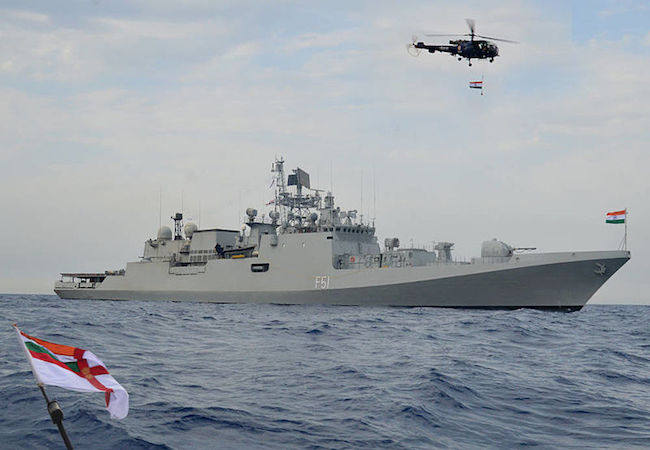
By Rahul Kumar
To achieve deterrence, and a true second strike capability, a nuclear-armedstate must deploy its nuclear subs and be willing to use the nuclear weapons when desired by the national leadership. But, at the same timeit poses several challenges given the fact that at sea it is difficult to manage the nuclear weapons. Therefore, it is important to analyze the challenges with regards to India’s naval nuclearization.
It was 1998, when India first leased a Charlie class submarine from Soviet Union, and later produced its first domestic nuclear ballistic missile submarine. And now it has operational nuclear submarine ‘INS Arihant’, which Indian prime minister Modi described on Nov. 5 as an “open warning for the country’s enemies” and a response to “those who indulge in nuclear blackmail.” The story invited the attention of the policy makers from around the world, but it escaped the eyes in Washington.
India has a (heavy) cross to bear, just because there are number of challenges at sea that ranges from readiness level of nuclear weapons, communication problems, and mad colonel dilemma. And how would (India) a new born nuclear-submarine capable state will deal with these challenges, particularly when the established nuclear powers (the United States, and Russia) have yet not achieved the perfection in managing the nuclear weapons at sea.
The communication problem
Nuclear submarines remainsubmerged under deep waters thus cut off with the world outside. But, at the same time,it is essential for the sub to receive survivable, and reliable information by the national leadership, in crisis or peacetime. Generally submarine communicates at VLF (very low frequency) or ELF (Extremely low frequency) bands. VLF waves can penetrate 8-10 meters, which means it cannot infiltrate the oceans depths or the salty waters. Therefore, to communicate at this band, the sub has to come the surface and thus reveal its location. This means that in crisis the commander might think about using the weapon at his/her own, to avoid the risk of being detected. Or rather he/she may remain underwatersto save the sub and souls it carries. During Cold War,when a Soviet sub found itself struggling against American ships that began using underwater explosive depth charges to force it to the surface. It couldn’t communicate Moscow for the orders. Therefore, commander himself decided to launch a nuclear torpedo but soon backed off his decision after having massive disagreements among the crews.
On the other hand,ELF can penetrate up to 100 meters in ocean depths, but the data rate remains very low. Bernice Baker writes that “Using ELF and VLF presents a number of disadvantages, however. The transmission sites have to be very large, meaning the submarine must tow cumbersome antenna cables, plus it usually has to align on a specific orientation and reduce speed to obtain optimal reception”. So, both communication systems seems problematic. How the Indian command centers would communicate with subs that are submerged in deep waters? The question needs the attention of the policy makers at New Delhi and Washington.
Readiness level and the MadColonel Dilemma
From the technicalstandpoint, deployment of nuclear weapons under the surface require that warheads are kept in close proximity to the missiles. It means that the Indian subcommanderswill now have the significant freedom to launch nuclearweapons, whenever they desire. How would India ensure the safety and security of nuclearweapons at sea? Fortunately these are just the thought experiments, but they do teach us some important lessons today.
Scenario 1.What if an Indian sub commander had faced a situation that puts him under high stress, sleeplessness, or pushed by the feeling of being wise enough to order the nuclear launch at the targets of his choice? Will the authority rests with the political leadership or the military commanders?
Scenario 2.What if the commander is unwilling to accept the orders or feedback that appears to detract from his self-defined immediate goals? And don’t forget in all scenarios,the sub commander has the ultimate authority to launch the nuclear weapons.
Unfortunately, all of these scenarios are too plausible.
Great power experience
Even the superpowers like the US had trouble in managing nuclear weapons at sea. In the United States Fleet Forces Comprehensive review it is advised that the present US Navy culture of ‘must-do’ undermines the safety standards. Therefore, “can do should never mean must-do. So, we must continue to encourage our Commanders to accept the risks when the benefit to be gained is worth the potential risk of failure…Under pressure to perform, and feeling ill-equipped to succeed, some leaders can stop listening to their team when feedback appears to detract from their immediate goals.” Strange is that a newly born nuclear sub capable state claims to be capable of managing nuclear weapons at sea better than the established ones. And India does have experienced accident in 2013, India’s Russian-built submarine, caused by on-board weapons, detonated by the fire, broke out overnight.
Conclusion
Unfortunately,the scenarios discussed above are all too believable, and India anewbornnuclear submarine capable state doesn’t have such an impressive nuclear command and control to deal with these critical issues. The path outlined here leads us to the conclusionthat India will face major challenges in managing its nuclear command and control at sea. However, India’s projection of nuclear subs in the IndianOcean will grip the risks of escalationand an armsrace.
Rahul Kumar is a freelance journalist and strategic studies analyst based in New Delhi, India.




